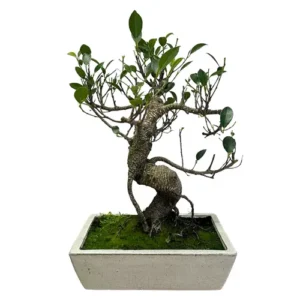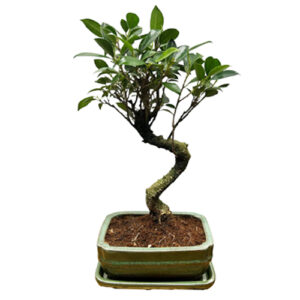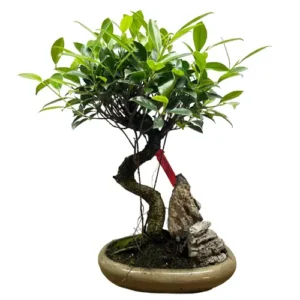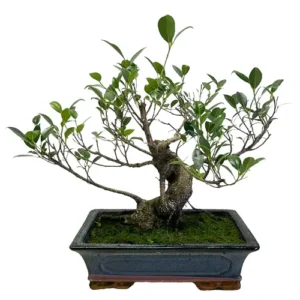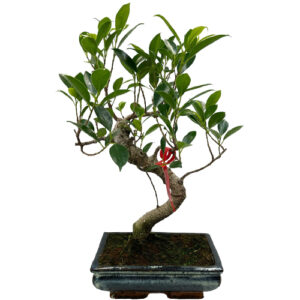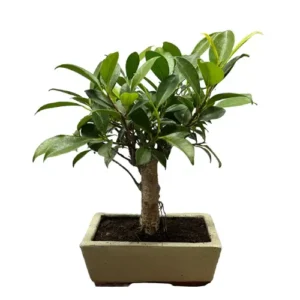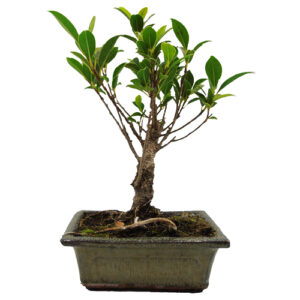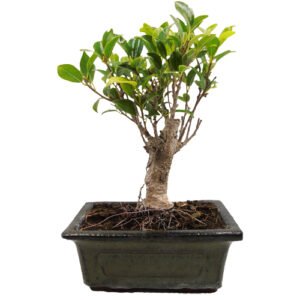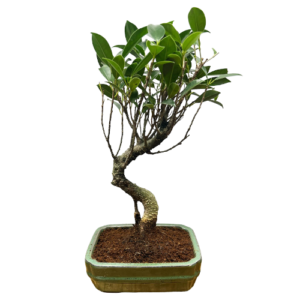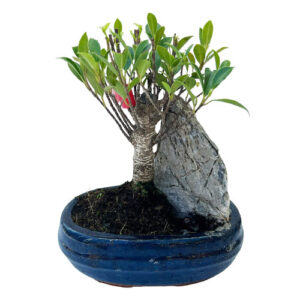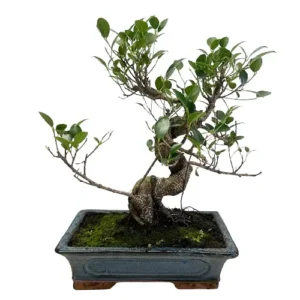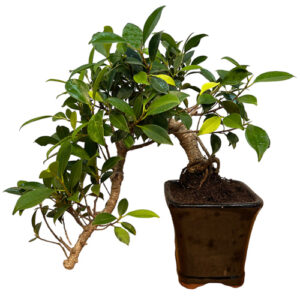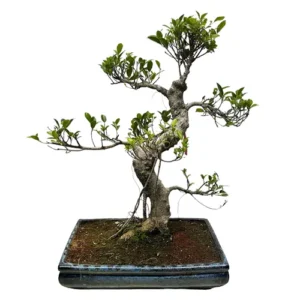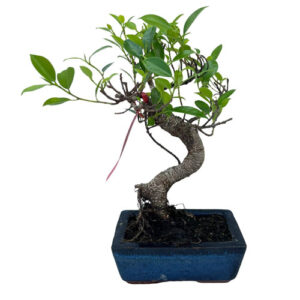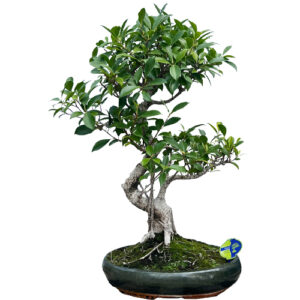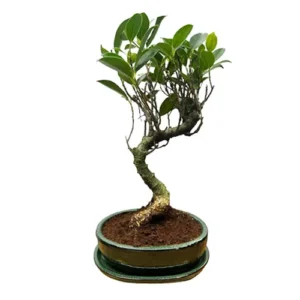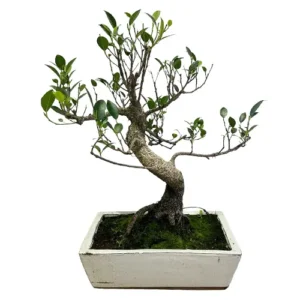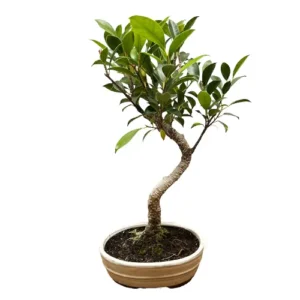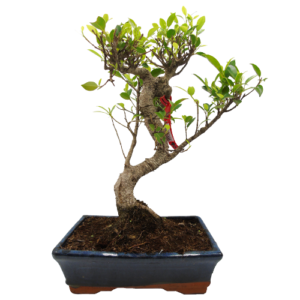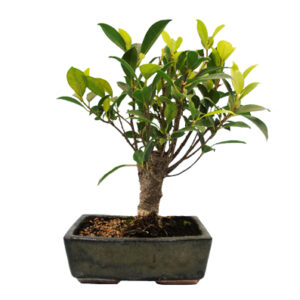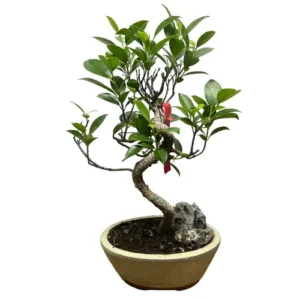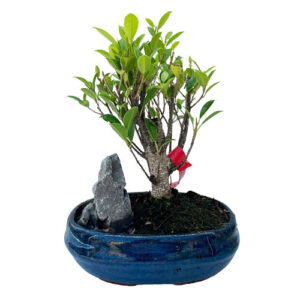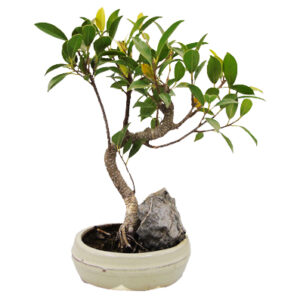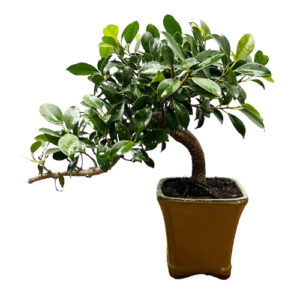Ficus Benjamina
Weeping Fig Bonsai
The ficus is the most popular bonsai for beginners, and the genus can be found in most tropical climates around the world, making it the perfect indoor variety. It has dark, waxy dark green leaves atop slender elegant trunk and branches. A Weeping Fig bonsai can bring a tropical touch to any indoor space.
Weeping Fig Bonsai Care Tips
Placement
The ficus bonsai should be kept indoors as it cannot endure frosts. They require a good amount of light so choose a space that receives plenty of full sunlight. If placed in a position with partial shade, keep an eye on the bonsai but this should not be a significant issue as they are a forgiving species which are easy to maintain.
The temperature of the room should be kept relatively constant and make sure you keep it away from central heating and cold draughts as this can dry out the root base. However, they will appreciate being placed outside during the summer to allow new growth, as long as temperatures do not drop below 15 °C. The ficus also benefits from higher humidity levels and will not develop aerial roots without it. Heightened humidity can be achieved by using a mister to spray the leaves, as well as placing a gravel tray under the pot to create a more humid microclimate around the tree.
Watering
Throughout the growing season water your Weeping Fig bonsai daily. During winter be sure to keep the soil moist but water less frequently than the growing season. Be sure to not waterlog the soil, this can bring on root rot.
Feeding & Fertilizing
Weeping Fig require feeding every 2-3 weeks across the growing season and once a month during the winter. Feeding in winter should be dictated by the growth. Organic pellets as well as liquid fertiliser can be used.
Pruning & Wiring
Regular pruning is advised for the Weeping Fig to maintain the plant’s desired shape. Removing any yellow or dead leaves and trimming back overgrown branches will encourage new growth.
The thin branches of the Weeping Fig mean it is suitable for wiring. However, do so with caution as they can cut into the bark. We recommend using wires with a thickness that matches the thickness of the branch: if the wire you choose is too thick you will damage the bark. If it is too thin, it won’t be effective.
Repotting
Repotting your tree is an important way to provide a fresh and suitable soil mix and ensure appropriate root health. Weeping Fig bonsai are fast-growing specimens. Repotting should take place in the Spring annually or whenever its roots become overcrowded.
Trees that are ready for repotting will require root pruning, a suitable new pot and appropriate soil mix.
When repotting, do not cut back the root mass by a large amount, and choose a well-draining soil mix that has a neutral or slightly higher PH value of 5-6 but not over 7. We tend to use a mixture of different speciality bonsai soils on our trees. Every species is different so please contact us for free soil-mix advice or to take advantage of our repotting service.
Bonsai make for a one-of-a-kind indoor plant offering elegance, nature and art all in one minute form. Across an array of exquisite and erudite species, they all demand their own specific care and cultivation needs in order for their beauty to flourish. We have an extensive library of care guides for indoor bonsai trees so you can make an informed and considered choice. It’s not about selecting the perfect bonsai, it’s about selecting the perfect bonsai for you.
Weeping Fig Bonsai - Typical Queries
How to propagate a Weeping Fig bonsai tree?
Cuttings are the best way to propagate a Weeping Fig. Start by cutting from a healthy branch with 2 leaves minimum, make 3-5 inches. Remove the lower half of the leaves from cutting. Plant in a container with drainage holes filled with peat moss, plant using the cut end. Exposed to bright indirect light, direct sunlight is to be avoided. Maintain humidity and misting. In two to six weeks the plant will take growth.
Is a Weeping Fig bonsai tree toxic?
Weeping Fig can be toxic to both pets and humans. The tree’s sap will irritate a stomach if ingested and will also irritate the skin. It’s advised to keep this tree out of reach of both pets and children.
How to deal with pests and diseases on a Ficus bonsai tree?
While a resilient species, Weeping Fig can incur diseases if not given the proper care. Discoloured leaves or spots on leaves are a sure sign that disease has onset. Remove branches and leaves to take care of this. Fungicide may be needed.
Regular inspection should be taken for aphids, mealybuds, scale or spider mites.
Can I grow a Weeping Fig bonsai tree outdoors?
This is a tropical species that would much prefer a warm environment from a temperate climate like the UK. It can be brought outdoors but only on the garantee of warm summer sun and temperatures.

